|
Report from
Europe
Europe’s wooden furniture consumption falls to lowest
level since 2015
The last three and half years, marked from the start of
2020 by the Covid-19 pandemic and from February 2022
by war in Ukraine, have seen unprecedented changes in
Europe’s wood furniture sector.
The sector passed through a period characterised by an
initial but very short-lived fall in demand in the second
quarter of 2020, followed by rapid demand escalation in
2021 at a time when material shortages and other logistical
challenges greatly reduced availability, and then by
another sharp decline starting in the second half of 2022
and continuing this year.
During this relatively short period, major changes have
occurred in patterns of supply and demand, trade flows,
consumer preferences and working conditions, distribution
channels, design, and fashion trends. Companies
throughout the sector are having to evolve new strategies
in response to a transformed world.
Recent trends in the value of production trade and
consumption of wood furniture in the EU27+UK are
shown in Chart 1. This highlights that the onset of the
pandemic led to a 9% downturn in the euro value of
EU27+UK wood furniture production and 8% decline in
consumption in 2020. This was followed in 2021 by a
strong 27% and 29% rebound in production and
consumption respectively. In 2022, production and
consumption fell back even more sharply than in 2020,
respectively by 11% and 12%.
Based on performance in the first half of 2023, production
and consumption are forecast to fall by another 6% and
10% this year. With a forecast value of around €38 billion
in 2023, European wood furniture production and
consumption this year are expected to be at a level not
seen since 2015.
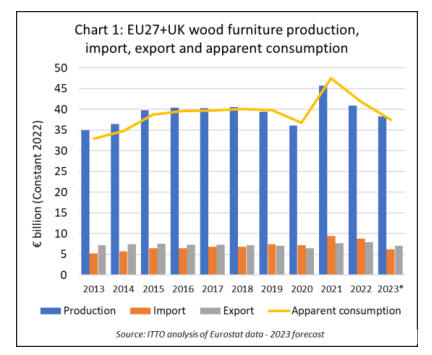
Furniture sector performance has varied widely between
European countries. Eurostat data shows that while overall
EU27 furniture production in 2023 is now at the level
prevailing in 2015, some countries including Romania,
Belgium, Sweden, Germany, Netherlands, Denmark, and
France, have fallen well below this level. Most of these
countries recorded only a modest rebound in furniture
production in 2021 followed by a dramatic downturn from
the second half of 2022 onwards.
In contrast, furniture production in Poland and Lithuania
continued strong even during the first year of the
pandemic in 2020 and increased very rapidly during 2021
and 2022. Although there has been a sharp downturn this
year, production in Poland and Lithuania is still well
above the pre-pandemic level.
Furniture production in Italy, Portugal and Spain has been
less volatile than in other European countries in the last
three and half years and is likely to remain above the pre-
pandemic level despite sliding this year (Chart 2).
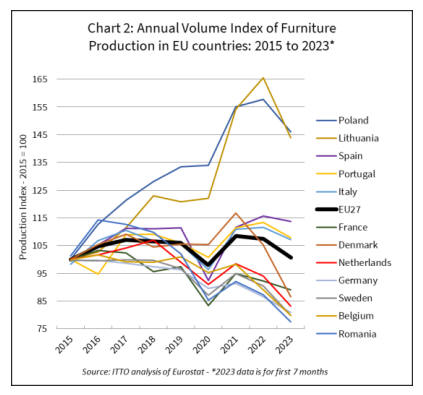
Recent trends in the quantity of European wood furniture
trade as revealed by Eurostat data are shown in Chart 3.
The long-term rise in European internal trade and in
imports from outside the region which began in 2013 as
the European economy gradually recovered from the
eurozone currency crisis, continued throughout the
pandemic in 2020 and accelerated in 2021.
European exports of wood furniture to countries outside
the region, which were flat in the period between 2013 and
2020, also increased in 2021. However, European imports,
exports and internal trade in wood furniture all declined
sharply in 2022, a trend which has continued in 2023
(Chart 3).
Internal EU trade in wood furniture in the first 6 months of
this year was down 20%, while imports fell 19% and
European exports were down 11%.
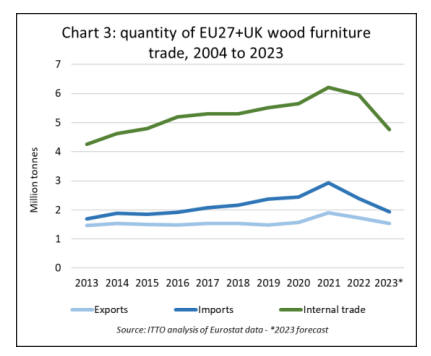
These figures underline the extent of the downturn in the
European economy. Consumer confidence and spending
has fallen sharply as state support for households is
running out and retail energy prices remain very high and
are expected to rise again during the winter months.
Higher interest rates have increased mortgage costs while
real incomes continued to be undermined by high levels of
inflation.
The latest purchasing managers’ indices reveal that
activity continues to contract in the European service
sector and in construction. Stingier bank lending is leading
to a 0.4 percentage-point reduction in GDP growth each
quarter, according to Goldman Sachs. Corporate
insolvencies in the EU rose by more than 8% in the year’s
second quarter, compared with the first, and have reached
their highest since 2015.
The impact of tighter monetary policy will peak in the
second half of this year, predicts Oliver Rakau of Oxford
Economics, a consultancy.
The total quantity of EU27+UK imports of wood furniture
from outside the region fell 18% in 2022 to 2.40 million
tonnes. In the first six months of this year, imports were
already down another 19%.
Total imports this year will likely be back to a level last
seen in 2016 (Chart 4). While declining imports in 2022
were at least partly due to continuing supply problems
caused by renewed COVID lockdowns in China and the
war in Ukraine, this year the leading driver has been a
dramatic falloff in European consumption.
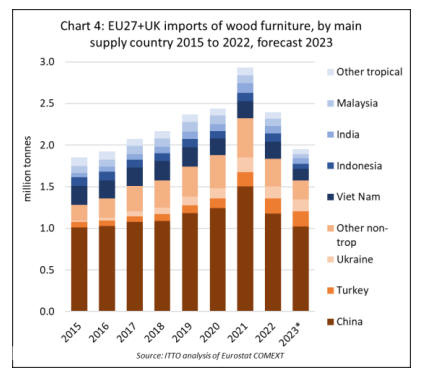
Wood furniture imports into the EU27+UK decreased
from all main supply regions during the first six months of
2023; by 13% from China to 550,000 tonnes, by 33% from
the tropics to 220,000 tonnes, and by 16% from other
countries to 300,000 tonnes (Chart 5).
Tropical countries have lost share in the European market
this year as supplies from China have come back online
with the end of COVID restrictions there.
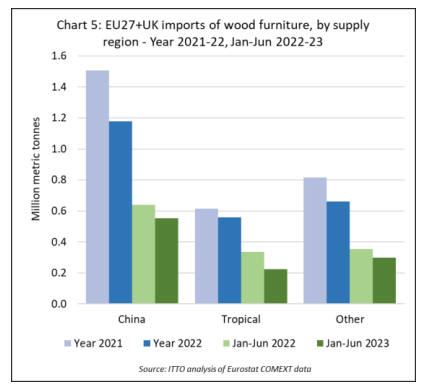
Imports from all tropical countries supplying wood
furniture to the EU27+UK declined very sharply in the
first six months of this year including Vietnam (-35% to
84,200 tonnes), Indonesia (-32% to 38,700 tonnes), India
(-33% to 35,600 tonnes), Malaysia (-37% to 33,700
tonnes), Brazil (-19% to 25,300 tonnes), Thailand (-71%
to 1,700 tonnes) and Singapore (-27% to 2,800 tonnes)
(Chart 6).

There was a sharp fall in tropical wood furniture imports
into the UK, the largest European market, in the first six
months of this year, down 38% to 67,600 tonnes.
Large declines were also recorded by France (-25% to
38,500 tonnes), Germany (-40% to 28,500 tonnes),
Netherlands (-35% to 23,900 tonnes), Belgium (-47% to
12,400 tonnes), Denmark (-27% to 6,300 tonnes), Italy (-
35% to 5,100 tonnes), Ireland (-38% to 4,800 tonnes), and
Poland (-35% to 4,800 tonnes).
Of all large European markets, only in Spain did imports
hold up reasonably well in the first half of this year,
reaching 15,100 tonnes, the same level as last year (Chart
7).
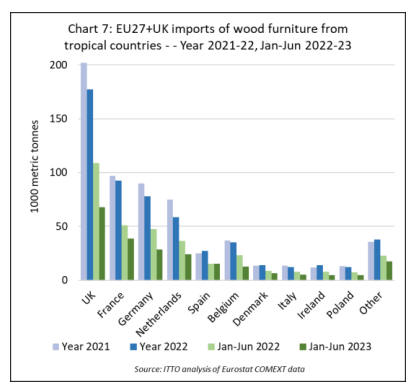
European outdoor furniture market at pre-pandemic
level
While trade data indicates a sharp downturn in tropical
wood furniture imports into Europe this year and last, the
latest report on the overall European outdoor furniture
market by CSIL, the Italian furniture industry market
research organisation, paints a more positive picture of
long-term prospects in this sector.
CSIL highlight that the increased attention paid to outdoor
spaces in recent years has boosted the demand for outdoor
furniture in Europe, which has seen significant growth,
outperforming on average the whole furniture sector.
Total annual sales of outdoor furniture in Europe are
estimated by CSIL to be around €3.3 billion. Following a
slight reduction in 2020 the sector recorded a double-digit
rebound in 2021, well above the sector average, and
remained buoyant in the first half of 2022.
The market slowed at the end of last year and in the first
half of 2023 but is still at around the pre-pandemic level.
The largest outdoor furniture markets within Europe are
Germany, the United Kingdom, France, and Italy,
accounting for a combined market share of over 50%.
According to CSIL, the growth of the European outdoor
furniture market has been driven by an array of factors,
such as house sales, residential and non-residential
construction, outdoor renovations, income availability, and
demographic changes. The pandemic played a significant
role to boost consumption of outdoor furniture and the
desire to experience outdoor spaces at home, in the office,
and in public spaces has remained strong. Demand came
from private consumers, contract, hotels, and office
design.
CSIL note that although the outdoor furniture market is
seasonal and strongly dependent on weather conditions,
customers now consider outdoor furniture as part of a
wider furnishing project, in line with a lifestyle concept in
which outdoor spaces are designed to be used all year
round with the terrace, balcony and garden seen as an
extension of indoor spaces.
European manufacturers and designers have responded to
the increasing demand for outdoor furniture by offering a
wide range of stylish and innovative options. Several
furniture companies formerly focused on interior products
have expanded their product portfolios to include outdoor
furniture, maintaining the characteristics of design and
comfort, with a focus and research on durable materials.
The presence of non-specialist outdoor brands, especially
from the upholstery, contract, and home furniture
segments, has grown significantly in the industry. Many of
these new players operate in the high-end and luxury
segments.
Outdoor furniture remains one of the best performing
furniture sectors in Europe and currently represents a 7%
share of total contract furniture sales in the region
according to CSIL figures. With a growing preference for
outdoor spaces, hotels, restaurants, cafés, and other
hospitality venues are ever more investing in high-quality,
durable outdoor furniture to enhance the onsite experience
of their guests.
With some of the world's most popular tourist destinations,
Europe experienced a significant revival in domestic and
inter-regional travel between the summers of 2021 and
2023. There has been strong expansion in the numbers of
hotel developments and refurbishments, further boosting
demand for outdoor furniture.
The outdoor sector is much more dependent on imports
than other furniture sectors in Europe. Slightly more than
half of all outdoor furniture imported by EU countries is
from countries outside the EU, with around 60% of non-
EU imports derived from China and 30% from tropical
countries in Southeast Asia.
Until last year, there was a long-term rising trend in
European imports of outdoor furniture from outside the
region. However, recent global supply challenges and
trade policy measures may lead to a partial reshoring of
sourcing activities in the next few years.
CSIL note that the outdoor furniture market is served via a
wide variety of channels, both specialist and non-specialist
distributors, from large scale retail chains to small
independent stores, and from 'pure' online players to brick-
and-mortar operators. Overall the role of non-specialist
retailers is higher in this sector than for most other
furniture sectors such as upholstery, kitchen furniture, and
office furniture.
DIY chains and garden centres are still pivotal sales
channels. However, there has been some growth in sales
via more specialist retailers in recent years, first as the
large-scale furniture chains expanded outdoor collections
and more recently as more independent retailers are
promoting designer outdoor brands.
The e-commerce channel is also growing rapidly. Both
manufacturers and retailers are extending their web
marketing activity and upgrading their on-line presence.
No longer do they only display product pictures and
prices, but also seek to guide and inspire customers with
design suggestions and case studies.
CSIL closely monitors the performance of the outdoor
furniture market in Europe through the comprehensive
Reports: ‘The Outdoor Furniture Market in Europe’ and
‘The Contract Furniture and Furnishings Market in
Europe’. These studies delve into statistics and indicators,
demand drivers, country analysis, competitive landscapes,
and product categories. More details are available at:
www.worldfurnitureonline.com.
|